How Long Is It Actually Okay To Spend In The Sun Before It Damages Your Skin?
With summer approaching, it'll soon be time to hit the beach and catch some rays. But nobody wants their summer fun to be ruined by a raging sunburn (and some unfortunate tan lines). When enjoying yourself outside, it's easy to forget how dangerous it really is to not wear SPF, which stands for sun protection factor. After all, forgoing sunscreen leaves your skin vulnerable to the sun's harsh rays, leading not only to painful sunburn but also raising the risk of skin cancer down the line.
We want to bask in the sun all day, but we need to be mindful of our skin. So, is there a certain amount of time we can stay in the sun before getting blisters and burns? While we wish there was just one clear-cut answer for everyone, it depends on a few factors: the UV index, your altitude, your skin type, and the SPF you're using. Luckily, there's an online tool that can help you stay safe in the sun, created by Dr. Małgorzata Koperska.
Using the Sunbathing Calculator
Partnering with Omni Calculator, Dr. Koperska created Sunbathing Calculator, which lets you know the maximum time you should stay outside, depending on some information you provide. It's a fairly simple and quick tool to use before spending a lot of time in the sun. All you have to do is input the sun intensity (ranging from winter to tropical), your skin type, and the SPF of your sunscreen. The calculator also asks about your approximate altitude and whether or not you're on snow or water, as these are both important factors in determining the sun's strength. Then, it will give you an approximate maximum time you should be outside before you're at risk for sun damage.
If you're unsure how much SPF you should be using, you can also use the reverse calculator. It allows you to input the amount of time you plan on spending outside, along with the other factors and calculates an appropriate SPF suggestion. After all, using an adequate amount of SPF is crucial in protecting your skin. Keep in mind, SPF doesn't correspond to the time you spend in the sun. In fact, the difference in SPF numbers really has to do with the amount and intensity of sun exposure you receive, according to the U.S. Food & Drug Administration (FDA).
Stay safe in the sun
Along with sitting in the shade and wearing protective clothing, SPF is the best way to avoid sun damage. The American Academy of Dermatology Association recommends using a water-resistant, broad-spectrum protection sunscreen with at least 30 SPF. Apply it 15 minutes before sun exposure and keep applying it every two hours to stay protected.
On hot days, be aware of the UV index, a scale ranging from 0 to 11+, which depicts the risk of sunburn due to the sun's UV radiation (via EPA). The UV index changes depending on your location and the season. For instance, on cloudy winter days, you'll likely see a UV index of one to two. And yes, you still need sunscreen in the winter. On the other hand, a scorching day in the summertime will be a lot higher, in the 8 to 10 range. This number increases with altitude, so if you're hiking on a mountain in the summer, be sure to stay protected. The higher the UV index, the faster you'll burn, so keep reapplying.


